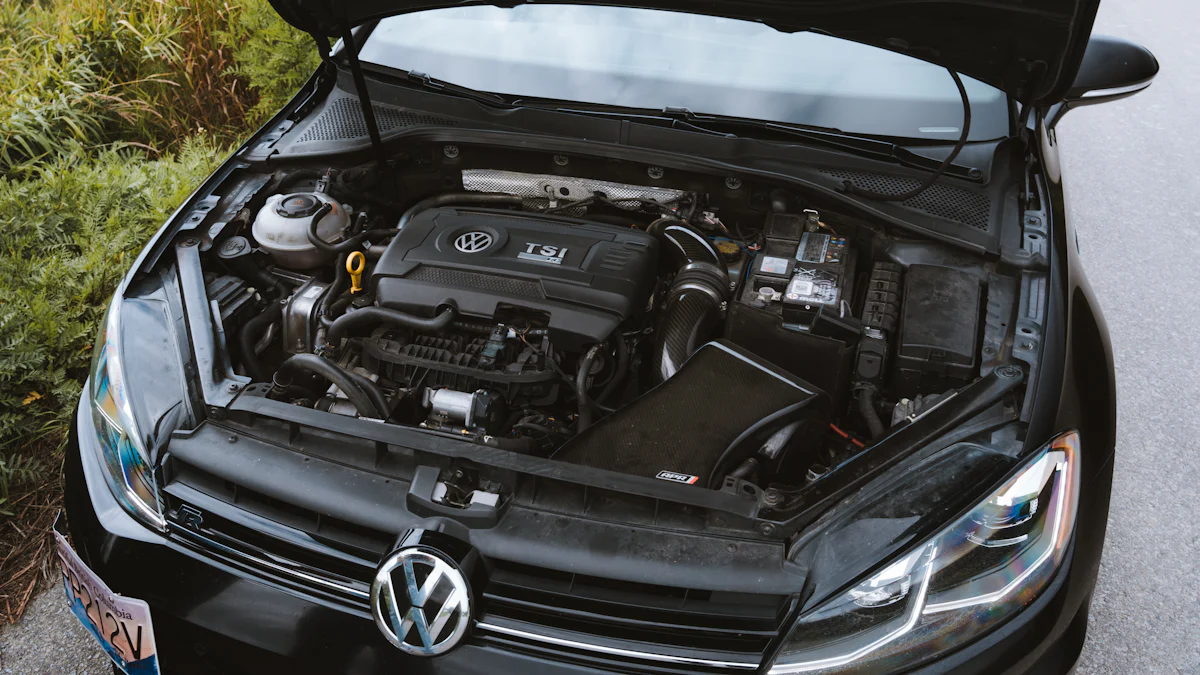Exploring the Roles of Front End Car Parts

Front end car parts play a crucial role in your vehicle’s safety and performance. These components, like the bumper, grille, and headlights, not only protect you during collisions but also enhance your driving experience. Understanding these parts helps you maintain your car effectively. For instance, regular front end alignment ensures your tires and suspension work harmoniously, improving ride quality and fuel efficiency. By knowing how these parts function, you can ensure your vehicle remains safe and reliable on the road.
The Bumper

Function and Importance
Impact Absorption
The bumper is one of the most vital front end car parts. It acts as a shield, absorbing impact during collisions. This energy absorption is crucial for protecting you and your passengers. Modern bumpers often include an energy absorber between the bumper beam and the bumper skin. This component adapts to different collision types, enhancing the bumper’s ability to absorb energy. By effectively controlling the force level, these absorbers minimize damage to your vehicle and reduce the risk of injury.
Aesthetic Contribution
Besides safety, bumpers also contribute to your car’s appearance. They provide a sleek and finished look, complementing the overall design. A well-maintained bumper enhances your vehicle’s aesthetic appeal, making it look polished and well-cared-for. This dual role of safety and style makes bumpers indispensable in the realm of front end car parts.
Maintenance Tips
Regular Inspection
To ensure your bumper performs its protective role, regular inspection is key. Look for signs of wear, such as cracks or deformities. These can compromise the bumper’s ability to absorb impact. Regular checks help you catch issues early, allowing for timely repairs or replacements. This proactive approach keeps your vehicle safe and maintains its structural integrity.
Repair and Replacement
When damage occurs, prompt repair or replacement is essential. A compromised bumper can significantly reduce your car’s safety features. Follow manufacturer guidelines when choosing replacement parts. Opt for high-quality options to enhance protection. By keeping your bumper in top condition, you ensure your vehicle remains safe and reliable on the road.
The Grille
Function and Importance
Engine Cooling
The grille is more than just a decorative feature on your car’s front end. It plays a crucial role in engine cooling. By allowing air to flow into the engine compartment, the grille helps regulate the temperature of the engine. This airflow is essential for maintaining optimal engine performance and preventing overheating. Studies have shown that different grille designs can significantly impact the balance between air resistance and thermal management. So, when you think about front end car parts, remember that the grille is vital for keeping your engine cool and running smoothly.
Aesthetic Design
While the grille serves a functional purpose, it also contributes to your vehicle’s overall aesthetic appeal. The design of the grille can give your car a distinctive look, enhancing its style and personality. Whether it’s a sleek, modern design or a classic, bold look, the grille adds character to your vehicle. A well-designed grille not only complements the car’s appearance but also reflects your personal taste. So, when choosing a car, consider how the grille design aligns with your style preferences.
Maintenance Tips
Cleaning and Care
Keeping your grille clean is essential for both its function and appearance. Dirt and debris can accumulate over time, potentially blocking airflow and affecting engine cooling. Regular cleaning ensures that the grille remains free of obstructions, allowing air to flow efficiently. Use a soft brush or cloth to remove dirt and grime, and consider using a gentle cleaner to maintain its shine. By taking care of your grille, you ensure that it continues to perform its vital role while looking great.
Damage Assessment
Regularly assessing your grille for damage is crucial. Look for cracks, dents, or other signs of wear that could compromise its effectiveness. Damage to the grille can affect airflow and, consequently, engine cooling. If you notice any issues, address them promptly to prevent further problems. Repairing or replacing a damaged grille ensures that your vehicle remains safe and efficient. By staying vigilant, you can keep your car’s front end in top condition.
Headlights

Function and Importance
Visibility Enhancement
Headlights are essential for enhancing your visibility on the road. They illuminate the path ahead, allowing you to see obstacles, road signs, and other vehicles clearly. This increased visibility is crucial, especially during nighttime or in poor weather conditions.
Safety in Low Light Conditions
Driving in low light conditions can be challenging, but headlights significantly improve safety. They make your vehicle more visible to other drivers and pedestrians, reducing the likelihood of collisions. Numerous studies have shown that simply turning on your headlights during the day can decrease accident rates. For instance, daytime headlight usage has been linked to a 5.7% reduction in two-vehicle crashes and a 12% decrease in pedestrian accidents. This safety feature is vital for protecting you and others on the road.
Maintenance Tips
Bulb Replacement
To keep your headlights functioning optimally, regular bulb replacement is necessary. Over time, bulbs can dim or burn out, compromising your visibility. Check your headlights periodically and replace any faulty bulbs promptly. When selecting new bulbs, consider options that offer enhanced brightness and longevity. By maintaining your headlights, you ensure that they continue to provide the visibility you need for safe driving.
Lens Cleaning
Clean lenses are crucial for effective headlight performance. Dirt, grime, and oxidation can accumulate on the lenses, reducing the amount of light they emit. Regular cleaning helps maintain clarity and brightness. Use a soft cloth and a gentle cleaner to remove any buildup. Keeping your lenses clean ensures that your headlights can illuminate the road effectively, enhancing both visibility and safety.
Fenders
Fenders are essential front end car parts that serve multiple purposes in your vehicle. They not only protect your car from debris but also provide structural support, ensuring a smooth and safe driving experience.
Function and Importance
Protection from Debris
Fenders act as a barrier between your car and the road, shielding it from debris like rocks, mud, and other particles. This protection is crucial for maintaining the integrity of your vehicle’s bodywork. Fenders are typically made from materials such as aluminum or steel, which offer robust protection. However, these materials can be challenging to repair due to their rigidity. On the other hand, materials like Dupont Zytel®, tough polycarbonate, and carbon fiber provide varying levels of durability and scratch resistance. Choosing the right material for your fenders can significantly impact their effectiveness in protecting your car.
Structural Support
Beyond debris protection, fenders play a vital role in providing structural support to your vehicle. They help maintain the shape and stability of the car’s body, especially during impacts. This support is essential for preserving the alignment and balance of your vehicle, contributing to a smoother ride. By reinforcing the car’s structure, fenders ensure that your vehicle remains stable and secure on the road.
Maintenance Tips
Rust Prevention
Rust can be a significant issue for fenders, especially those made from metal. To prevent rust, regularly inspect your fenders for any signs of corrosion. Applying a rust-proof coating can help protect the metal surfaces from moisture and other elements that cause rust. Keeping your fenders clean and dry is also crucial in preventing rust formation. By taking these preventive measures, you can extend the lifespan of your fenders and maintain their protective capabilities.
Damage Repair
Fender damage can occur from minor accidents or contact with debris. Addressing any dents or scratches promptly is essential to prevent further issues. For metal fenders, precise reshaping may be necessary to restore their original form. If the damage is extensive, consider replacing the fender with a high-quality option that matches your vehicle’s specifications. Regular maintenance and timely repairs ensure that your fenders continue to provide the protection and support your car needs.
Steering and Suspension Systems
The steering and suspension systems are vital front end car parts that ensure your vehicle’s stability and control. They work together to provide a smooth and safe driving experience.
Function and Importance
Vehicle Stability and Control
Your car’s steering system is crucial for maintaining stability and control. It allows you to direct the vehicle precisely, ensuring you can navigate turns and curves safely. The suspension system complements this by absorbing shocks from the road, keeping your car stable even on uneven surfaces. Together, these systems help you maintain control, reducing the risk of accidents.
Smooth Movement and Handling
A well-functioning suspension system ensures smooth movement and handling. It absorbs bumps and vibrations, providing a comfortable ride for you and your passengers. This system also helps keep your tires in contact with the road, improving traction and handling. When your suspension works properly, you enjoy a more pleasant and controlled driving experience.
Maintenance Tips
Regular Alignment Checks
Regular alignment checks are essential for keeping your steering and suspension systems in top condition. Misalignment can cause uneven tire wear and affect your vehicle’s handling. By checking the alignment regularly, you ensure that your car remains stable and easy to control. This simple maintenance step can extend the life of your tires and improve your driving experience.
Component Inspection
Inspecting the components of your steering and suspension systems is crucial for identifying potential issues early. Look for signs of wear or damage, such as leaks or unusual noises. Addressing these problems promptly can prevent more significant issues down the road. Regular inspections help you maintain the performance and safety of your vehicle, ensuring a smooth and reliable ride.
How Front End Parts Work Together
Understanding how front end car parts work together can significantly enhance your vehicle’s safety and performance. Each component plays a unique role, but their combined efforts create a seamless driving experience.
Synergy for Safety
Integrated Protection
Front end car parts like the bumper, grille, and fenders form a protective shield around your vehicle. They absorb impact during collisions, reducing damage and keeping you safe. The front end assembly connects these parts to the steering and suspension systems, ensuring they work in harmony. If any component wears out or becomes loose, it can lead to dangerous driving conditions. Regular maintenance helps keep everything in check, providing integrated protection for you and your passengers.
Aerodynamic Efficiency
Aerodynamics play a crucial role in vehicle safety. The design of front end parts like the grille and fenders helps reduce air resistance, allowing your car to move smoothly through the air. This efficiency not only improves fuel economy but also enhances stability at high speeds. By maintaining the aerodynamic features of your vehicle, you ensure a safer and more efficient drive.
Synergy for Performance
Engine Cooling and Efficiency
The grille and other front end components work together to keep your engine cool. They allow air to flow into the engine compartment, preventing overheating and ensuring optimal performance. A well-cooled engine runs more efficiently, saving you fuel and reducing emissions. Regular checks and cleaning of these parts help maintain their effectiveness, contributing to your vehicle’s overall performance.
Enhanced Driving Experience
The synergy between front end parts and the steering and suspension systems creates a smooth and responsive driving experience. The suspension absorbs road shocks, while the steering system provides precise control. Together, they ensure your vehicle handles well, even on rough terrain. By keeping these systems in top condition, you enjoy a comfortable and controlled ride every time you hit the road.
Front end car parts are essential for your vehicle’s safety and performance. Each component, from the bumper to the steering system, plays a vital role in ensuring a smooth and secure driving experience. Regular maintenance is crucial. It helps you catch issues early, keeping your car in top condition. Don’t overlook tasks like front-end alignment, which automakers recommend every 50,000 miles. Staying informed about these parts empowers you to handle repairs promptly, enhancing your vehicle’s longevity and reliability. Keep learning and caring for your car to enjoy a safer ride.
